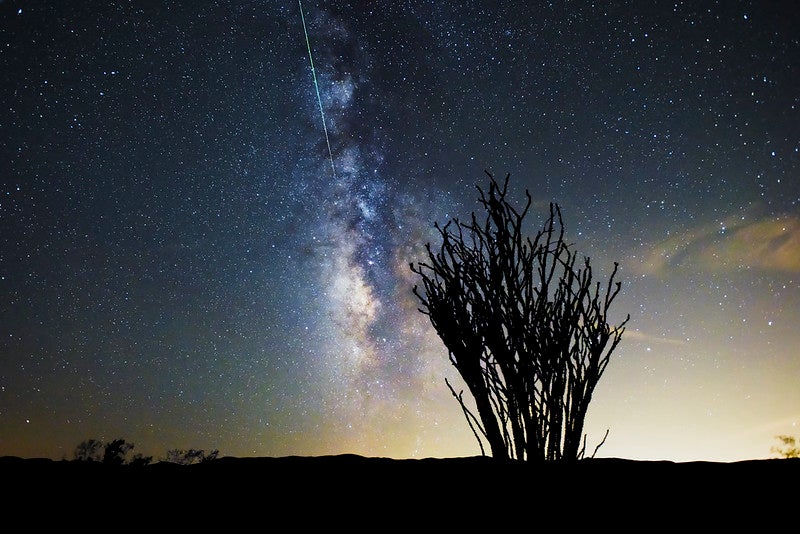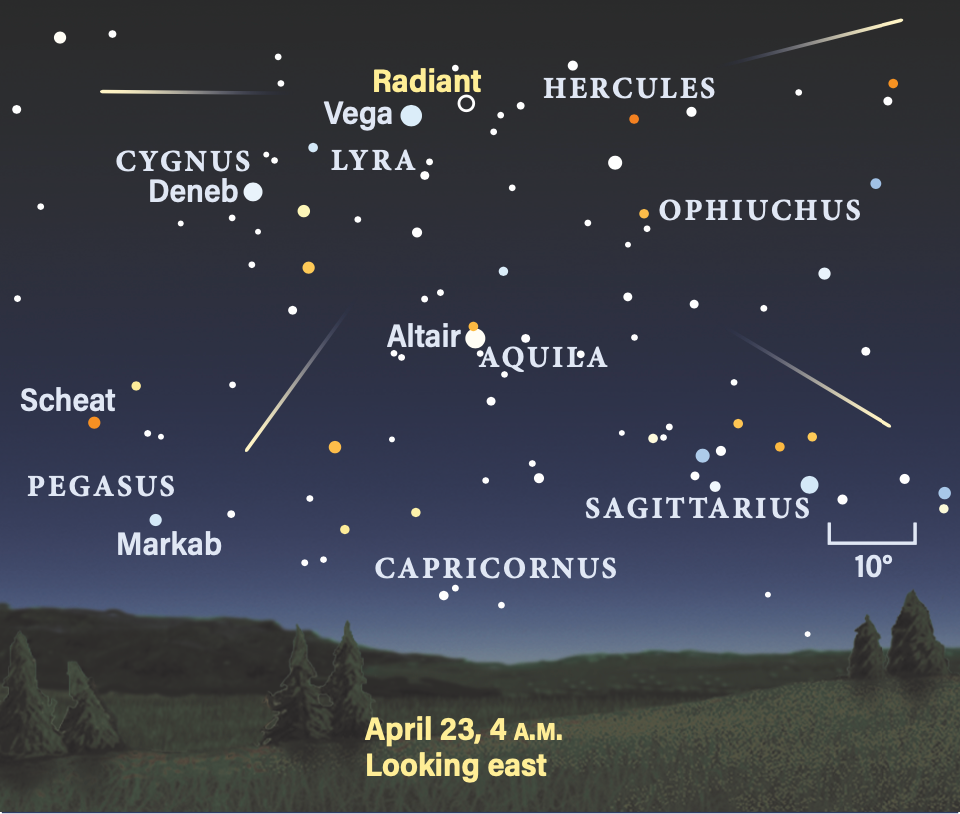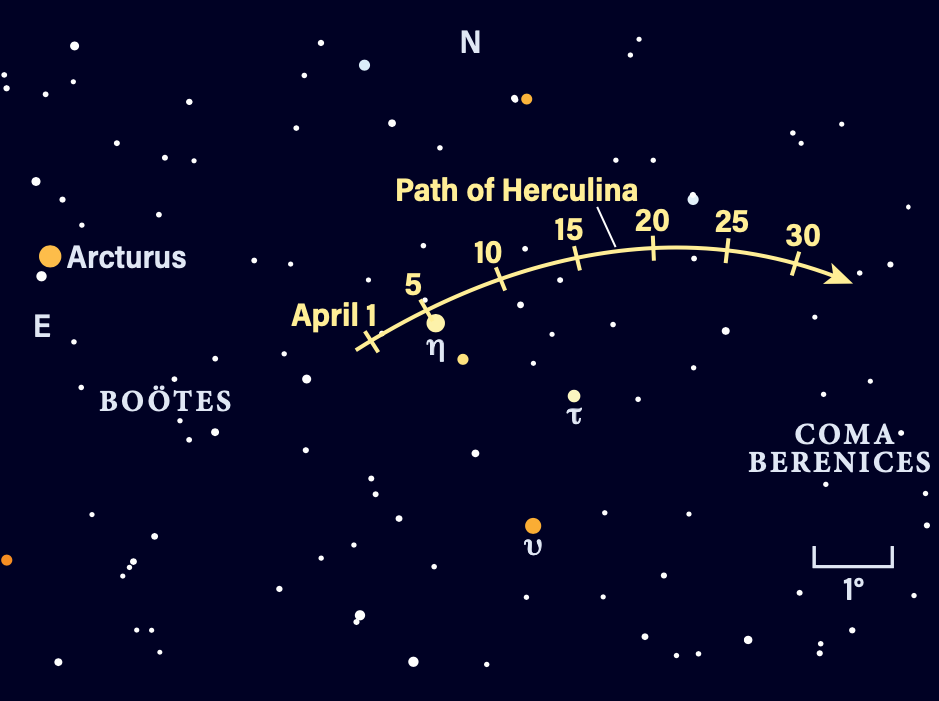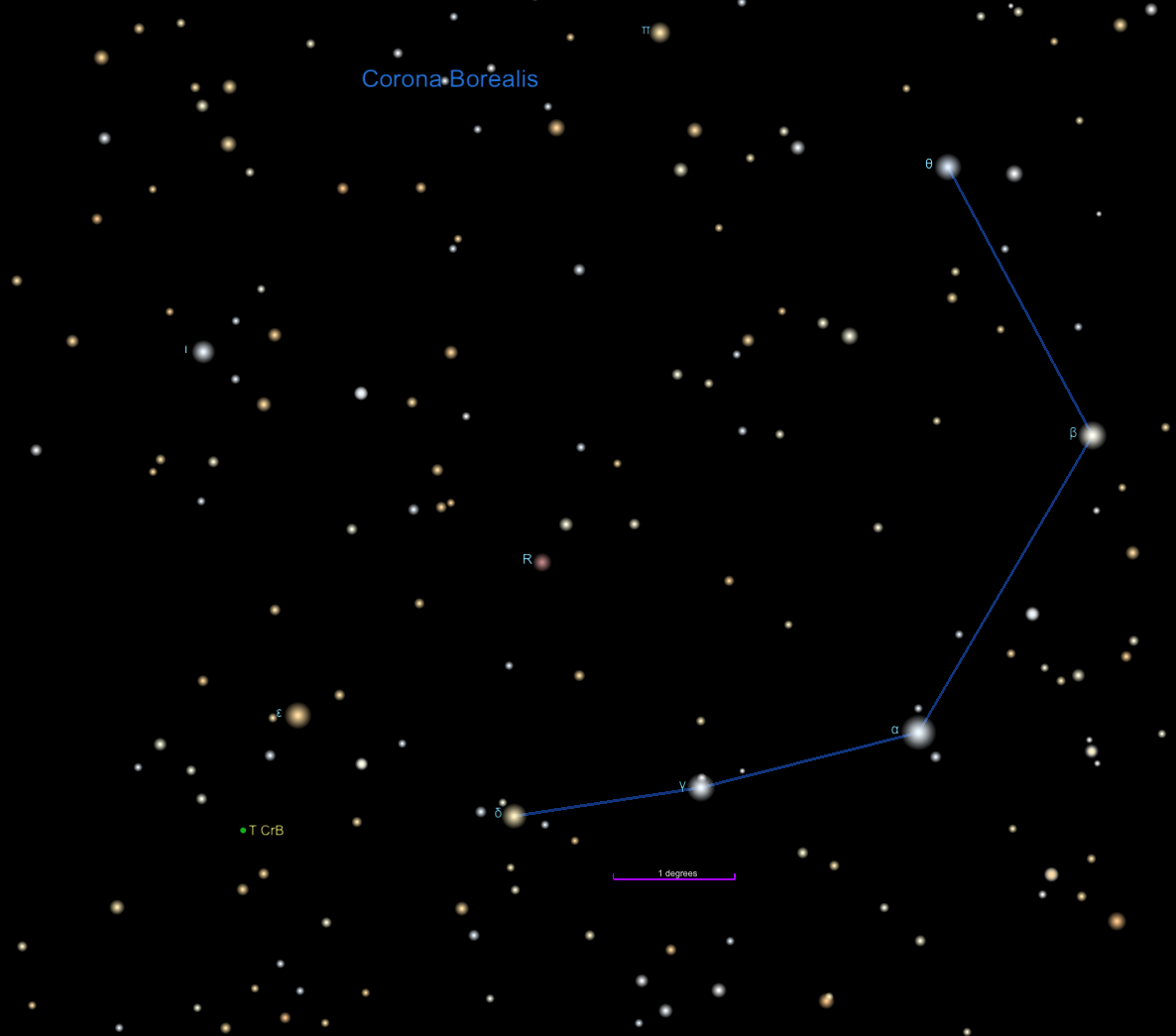
Friday, April 19
The Moon reaches apogee, the farthest point from Earth in its orbit, at 10:10 P.M. EDT. Our satellite will sit 252,043 miles (405,624 kilometers) away at that time.
As the Moon rises this evening, you’ll notice it is nearly Full. We’re just a few days from that lunar phase, as sunrise quickly sweeps across the surface. By tonight, it’s reached the crater Gassendi in the lunar southwest. Check out that region with a telescope to explore the dynamic surface of our satellite.
Gassendi sits on the northwestern rim of Mare Humorum, the Sea of Moisture. Focusing first on the larger mare, note the arcs visible in its eastern region. These are evidence geologic activity over time.
The 70-mile-wide (113 km) Gassendi Crater has also undergone some upheaval. Its distinct cluster of central peaks really draws the eye. Gassendi also sports a small, deep crater on its own northern rim, whose formation pushed much of the material inside Gassendi toward the center.
Sunrise: 6:15 A.M.
Sunset: 7:43 P.M.
Moonrise: 3:48 P.M.
Moonset: 4:34 A.M.
Moon Phase: Waxing gibbous (84%)
*Times for sunrise, sunset, moonrise, and moonset are given in local time from 40° N 90° W. The Moon’s illumination is given at 12 P.M. local time from the same location.
Saturday, April 20
Jupiter passes 0.5° south of Uranus at 4 A.M. EDT. By half an hour after sunset, the pair stand 12.5° high in Aries in the west, still the same distance apart. Faint Uranus (magnitude 5.9) stands just to the upper right of brighter Jupiter; the gas giant is magnitude –2 and readily visible with the naked eye, while the more distant ice giant will require binoculars to catch in the fading twilight. All four Galilean moons are arrayed about Jupiter this evening: Callisto stands alone to the west, while Europa (closest), Io (middle), and Ganymede (farthest) appear strung out to the east.
Don’t spend too long on the planets, however, as this may be one of your last chances to catch Comet 12P/Pons-Brooks in the Northern Hemisphere. The comet is flying near Xi (ξ) Tauri tonight, located about 8° south-southeast (to the lower left) of Jupiter. It’s lower in the sky — just under 10° in altitude half an hour after sunset — so you’ll want to start looking early and keep your gaze trained on the area as it grows darker. The region is sinking quickly into the horizon, where the glow of city or streetlights — not to mention thicker, more turbulent air — will start to mar the view.
Pons-Brooks was last recorded around magnitude 4.5, which should render it bright enough to view with binoculars, even in the twilight glow. The odds are stacked against you, though, and its visibility north of the equator is quickly diminishing as the comet approaches perihelion (the closest point to the Sun in its orbit) tomorrow.
Sunrise: 6:14 A.M.
Sunset: 7:44 P.M.
Moonrise: 4:47 P.M.
Moonset: 4:54 A.M.
Moon Phase: Waxing gibbous (90%)
Sunday, April 21
Let’s check in on Mars and Saturn in the morning sky. Earlier this month, they stood just 0.5° apart — how much distance have they put between themselves in the past 11 days?
Forty minutes before sunrise, the planets are roughly 10° high in the east. Saturn lies to the upper right, shining at magnitude 1, while Mars is now 7° to the ringed planet’s east and just 0.1 magnitude fainter. You may want binoculars or a small scope to help you pick out the planets against the brightening backdrop of the sky.
Use your optics to zoom in on them one at a time. Though much more distant, Saturn appears larger, with a disk that spans 16″ and rings that stretch more than twice that. The planet’s brightest moon, Titan, may just be visible 1′ to the planet’s east. The large moon will quickly grow more difficult to see as the sky brightens, even though Saturn is rising.
Mars is much smaller despite its proximity to Earth. The ruddy disk is just 5″ across. Imagers and those with larger scopes and a keen eye might be able to pick up a few darker regions — Mare Sirenum and Mare Cimmerium — in the planet’s southern hemisphere, but it will be tricky.
Sunrise: 6:13 A.M.
Sunset: 7:45 P.M.
Moonrise: 5:47 P.M.
Moonset: 5:13 A.M.
Moon Phase: Waxing gibbous (95%)

Monday, April 22
The Lyrid meteor shower peaks tonight! The best time to catch shower meteors is either early this morning in the hours before dawn or overnight tonight into early tomorrow morning. That’s because meteor showers are best seen in the early-morning hours, as those positions on the planet getting ready for dawn are rotating into the direction of Earth’s motion.
If you’re out this morning around 4 A.M., look east to spot the three bright stars of the Summer Triangle. The Lyrids originate from a point near Vega, which is the magnitude 0 star that marks the highest point in the Triangle as it rises. The other two stars are Deneb to Vega’s lower left and Altair to Vega’s lower right.
Although the radiant lies near Vega, you’ll want to look some 40° or so to one side or the other of this star. That’s because shower meteors show off the longest trains through the sky in regions adjacent to — but not directly centered on — the radiant. Because of the bright Moon, only the very brightest shower meteors will be visible, so you might expect to see about 6 or so per hour, down from the shower’s maximum rate of some 18 meteors per hour.
Nonetheless, because you will only see the brightest meteors, they’re likely to be memorable. If the weather is mild and the skies are clear, there’s no reason not to step outside today and tomorrow before dawn to catch the show.
Sunrise: 6:11 A.M.
Sunset: 7:46 P.M.
Moonrise: 6:47 P.M.
Moonset: 5:32 A.M.
Moon Phase: Waxing gibbous (98%)
Tuesday, April 23
Full Moon occurs at 7:49 P.M. EDT, bringing us April’s Pink Moon. As previously mentioned, however, the bright not-quite-yet-Full Moon in the pre-dawn sky will likely wash out all but the brightest Lyrid meteors if you try to catch them early this morning.
Because that bright moonlight will also wash out most deep-sky objects as well, the Full Moon is a time best spent observing brighter objects, such as stars. In fact, because fainter stars become harder to see, some constellations and asterisms may stand out all the better.
If you’re out this evening, look north to spot perhaps the two most famous asterisms in the northern sky: the Big and Little dippers.
The Little Dipper is anchored at the end of its handle by 2nd-magnitude Polaris, also known as the North Star. From there, the handle arcs upward (when viewed early this evening), jumping from Delta (δ) to Epsilon (ϵ) Ursae Minoris. The cup is formed by four stars: Zeta (ζ), Eta (η), Gamma (γ), and Beta (β) UMi (also called Kochab).
Now, look above the Little Dipper to find the Big Dipper in Ursa Major. The two dippers are depicted such that they always pour into each other — so, since the Little Dipper is right-side up, the Big Dipper is upside down. The handle of the Big Dipper starts with Alkaid (Eta Ursae Majoris), then arcs inward to Zeta and Epsilon UMa. Zeta UMa is also called Alcor — if your eyesight is particularly keen, you may notice this star has a faint companion also visible to the naked eye — this is Mizar. The Big Dipper’s cup or bowl is formed by the four stars Delta, Gamma, Beta, and Alpha UMa.
Sunrise: 6:10 A.M.
Sunset: 7:47 P.M.
Moonrise: 7:49 P.M.
Moonset: 5:53 A.M.
Moon Phase: Full
Wednesday, April 24
Mercury reaches its stationary point at 4 A.M. EDT, ending its retrograde track; after today, it will begin moving eastward against the more distant background stars.
Although the tiny planet is above the horizon shortly before dawn, its faint magnitude of 2.4 will render it essentially invisible. However, give it just a few days — by the end of the month, it will reach 1st magnitude, allowing observers to pick it out in the half hour before dawn.
Instead, let’s enjoy not a planet, but the rival of one: the star Antares in Scorpius, whose red glow is often confused for the planet Mars. Antares sits some 20° above the southern horizon at 5 A.M. local daylight time. Although Scorpius lies near Virgo (which currently houses the bright Moon), Antares’ magnitude 1.1 glow should still be visible. Through a telescope, particularly while this star is low to the horizon, it may appear to jump or sparkle as you view it through the thick, turbulent layer of air near the horizon.
Antares is a red supergiant star that is cooler than the Sun, but also much brighter, shining some 60,000 times brighter than the Sun when its full luminosity, including infrared light, is taken into account. This massive, aging sun has a companion that glows at magnitude 5.5 and sits just 3″ away. Because it’s buried within Antares’ energetic solar wind, the companion, according to Jim Kaler’s STARS website, can take on a greenish cast, rather than its natural blue-white.
Sunrise: 6:08 A.M.
Sunset: 7:48 P.M.
Moonrise: 8:54 P.M.
Moonset: 6:16 A.M.
Moon Phase: Waning gibbous (99%)

Thursday, April 25
Asteroid 532 Herculina is making its way through the constellation Boötes this month, nearing its western border and the region occupied by Coma Berenices.
You’ll find the 100-mile-wide (160 km) main-belt world west of the bright star Arcturus. Tonight, Herculina is located 8.7° west of this star, and just 3.8° west of 3rd-magnitude Eta Boötis. Despite Herculina’s faint magnitude of 9.1, it’s so far above the ecliptic that the Moon’s glare shouldn’t interfere much with your search.
Once you’ve found Herculina with binoculars or a telescope, keep skimming west into Coma Berenices to land on the Coma Star Cluster, also cataloged as Melotte 111 and Collinder 256. This open star cluster sits near Gamma Comae Berenices in the western region of this constellation. Spanning about 4°, the Coma Cluster contains dozens of stars down to 10th magnitude, offering a rich view even at lower magnification. In fact, the cluster has a combined magnitude of 1.8, making it visible to the naked eye particularly under good conditions.
Sunrise: 6:07 A.M.
Sunset: 7:49 P.M.
Moonrise: 10:01 P.M.
Moonset: 6:44 A.M.
Moon Phase: Waning gibbous (97%)

Friday, April 26
Let’s return to Antares in Scorpius this morning as the waning gibbous Moon prepares to pass just 0.3° north of this red giant star at 5 P.M. EDT. Early this morning the Moon still sits some 6.2° west of Antares, having just passed between the space between Pi (π) and Delta Scorpii. Tomorrow morning, the Moon will sit east of Antares after passing the star this evening while not visible in the sky.
Hanging above Scorpius is the constellation Ophiuchus; above that is Hercules, and to Hercules’ right is the small, curved constellation Corona Borealis. The Northern Crown holds a special star that has been making headlines recently, as it’s about to put on a show: T Coronae Borealis, or T CrB, one of the sky’s few recurrent novae.
The star is currently magnitude 10, requiring binoculars or a small scope to spot. To find it, start with Corona Borealis’ alpha star, which shines at magnitude 2.2. Then move your gaze eastward along the curve of the crown, jumping to magnitude 3.8 Gamma and then magnitude 4.6 Delta CrB. T CrB sits just over 2° farther east of Delta. When the nova flares, T CrB will rival Alpha CrB in brightness, briefly adding another star to the Northern Crown!
Astronomers aren’t exactly sure when T CrB will brighten, but they know it will do so quickly and for only a short period of time. It’s expected to happen within the next few months, so keep your eyes on the sky to see this once-in-a-lifetime event.
Sunrise: 6:06 A.M.
Sunset: 7:50 P.M.
Moonrise: 11:08 P.M.
Moonset: 7:18 A.M.
Moon Phase: Waning gibbous (93%)

Sky This Week is brought to you in part by Celestron.









